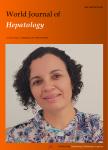Atypical presentation of a hepatic artery pseudoaneurysm:A case report and review of the literature
Atypical presentation of a hepatic artery pseudoaneurysm:A case report and review of the literature作者机构:Department of SurgeryColleges of MedicineUniversity of Florida Health Science Center Department of SurgeryColleges of MedicineUniversity of FloridaHealth Science Center Department of PathologyColleges of MedicineUniversity of Florida Health Science Center
出 版 物:《World Journal of Hepatology》 (世界肝病学杂志(英文版)(电子版))
年 卷 期:2016年第8卷第18期
页 面:779-784页
学科分类:1002[医学-临床医学] 100210[医学-外科学(含:普外、骨外、泌尿外、胸心外、神外、整形、烧伤、野战外)] 10[医学]
主 题:Klatskin tumor Cholangitis Hepatic artery pseudoaneurysm Biliary obstruction Trisegmentectomy
摘 要:Classically, hepatic artery pseudoaneurysms(HAPs) arise secondary to trauma or iatrogenic causes. With an increasing prevalence of laparoscopic procedures of the hepatobiliary system the risk of inadvertent injury to arterial vessels is increased. Pseudoaneurysm formation post injury can lead to serious consequences of rupture and subsequent hemorrhage, therefore intervention in all identified visceral pseudoaneurysms has been advocated. A variety of interventional methods have been proposed, with surgical management becoming the last step intervention when minimally invasive therapies have failed. The authors present a case of a HAP in a 56-year-old female presenting with jaundice and pruritis suggestive of a Klatskin s tumor. This presentation of HAP in a patient without any significant past medical or surgical intervention is atypical when considering that the majority of HAP cases present secondary to iatrogenic causes or trauma. Multiple minimally invasive approaches were employed in an attempt to alleviate the symptomology which included jaundice and associated inflammatory changes. Ultimately, a right hepatic trisegmentectomy was required to adequately relieve the mass effect on biliary outflow obstruction and definitively address the HAP. The presentation of a HAP masquerading as a malignancy with jaundice and pruritis, rather than the classic symptoms of abdominalpain, anemia, and melena, is unique. This presentation is only further complicated by the absent history of either trauma or instrumentation. It is important to be aware of HAPs as a potential cause of jaundice in addition to the more commonly thought of etiologies. Furthermore, given the morbidity and mortality associated with pseudoaneurysm rupture, intervention in identifiable cases, either by minimally invasive or surgical interventions, is recommended.



